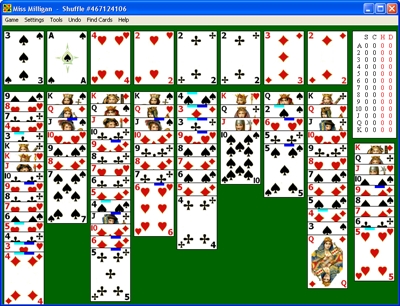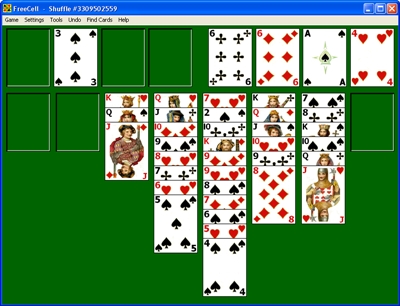The Solitaire Games of Skill collection allows the player to play solitaire games with less mouse movement and clicks
using the features described below.
-
When a mouse click can replace several clicks
-
Moving cards in sequence with one click when only one card can be moved at a time
When playing computerized FreeCell more than one card can be moved at a time based on the number of spaces in the tableau and number of empty cells. This concept of moving more than one card at a time is extended to games like Spider and Beleaguered Castle. Also the concept of moving more than one card at a time is expanded to take into account intermediate building. In the Spider screen shot below the nine of diamonds in column seven and all the cards above it can be moved to the ten of diamonds in column three with a single click. This move is permitted since during the process of moving the nine, the two of hearts in column seven can be moved to the three of hearts in column six while the six of hearts in column seven can be moved to the seven of diamonds in column eight. This allows the nine of diamonds in column seven together with the remaining cards above it to be moved to the ten of diamonds in column three. Then the remaining cards originally in column seven can rejoin the nine of diamonds in column three.

-
Moving several sequences to different locations with one click
Clicking on the lowest card marked with a blue strip in a column will send that card and all the cards above it to different columns in the layout. For example clicking on the bottom card in column five of the Miss Milligan screen shot below will result in the the nine of hearts being sent to column six, the three of clubs to column one, the three of diamonds to column six, and the four of spades to the first foundation column.

-
Swapping columns
Columns can be swapped in order to get cards of the same suit together for games like Spider and Beleaguered Castle. In the Spider screen shot above, in order to get the eight diamonds in column six together with the nine of diamonds in column seven, the eight of diamonds can be moved over the eight of clubs in column seven with the mouse. After letting go the eight of diamonds with the mouse, the columns will swap moving the eight of clubs to column six while the eight of diamonds is just under the nine of diamonds in column seven. Under normal conditions this swap would require around thirty separate moves. With so many moves required the player might decide not to make the swap. That decision could cost him the game. Swapping is only permitted if the same result could be achieved by moving one card or suit sequence at a time.
-
Moving cards in sequence with one click when only one card can be moved at a time
-
When the mouse can be moved less often
-
Moving a card by clicking below the position where you want it to go
If the mouse is already near the position you want a card to go, you can click below that position to move the card there. In fact when playing FreeCell if all four cell cards can go on a single position in the tableau, clicking once below that tableau position will send all four cards to that position. In the Spider screen shot above, clicking just below the ten of diamonds in column three will cause the nine of diamonds and all the cards above it in column seven to be built on the ten of diamonds. -
Deal cards by clicking anywhere in the layout
Moving the mouse back and forth between the hand and the rest of the layout is unnecessary since clicking anywhere there is not a card that can be moved will deal the cards in the hand. -
When you do not have to run through the whole hand when playing with unlimited deals
For the versions of Klondike, Harp, and Pyramid offered here under the names of Klondike Garden, Harp Garden, and Accordion Pyramid respectively, there are unlimited deals. Since the deals are unlimited, any card in the hand is accessible at any time. To make things easier for the player when playing these games, all the hand cards are spread out so that they are all visible and available at the same time. The player does not have to tediously go through the deck each time to get a particular card. Even though the Accordion Pyramid hand cards are spread out, play is the same as for a normal layout. Thus a hand card can only be paired with another hand card if the two hand cards are in adjacent positions. This simulates pairing a hand card with a wastepile card in a normal game.
In the regulation Canfield game, cards from the hand are counted off in groups of three and placed on a single wastepile. The top card of this wastepile is available for play. There is no limit to such redealing. The wastepile displayed for this Canfield game tries to duplicate the preceding process while reducing the amount of card shuffling. The wastepile cards seen by the player are the wastepile cards he would see when counting off the cards by threes. In the regulation game, if a player plays a wastepile card he would not be able to retrieve covered wastepile cards until the next redeal. This rule is duplicated here by not allowing access to cards above a played card that would not be acessible in a regulation game. A black bar divides the accessible cards from the inaccessible.
-
Moving a card by clicking below the position where you want it to go
-
When the mouse cursor changes from an arrow to a hand when foundation building is allowed
In multiple wastepile games of the Sir Tommy type, cards can be moved from the wastepiles to the foundations only after a certain number of cards have been dealt. It is easy for the player to miss this time when cards can be built on foundations. The mouse cursor changes from an arrow to a hand to remind the the player that he can build on foundations. -
When the game is obviously won the remaining moves are done automatically
When a game is obviously won the remaining moves are performed automatically for most games. These moves can include moving cards to cells and different positions in the tableau. The FreeCell game in the screen shot below is pretty much won. It just remains to unscramble columns five and seven. Right clicking on the bottom of column five will unscramble column five and column seven will automatically unscramble itself requiring no futher moves of the player. Cards in column seven will be sent to the three empty cells and to various columns in the tableau. Then all the cards will be automatically moved to the foundations.
